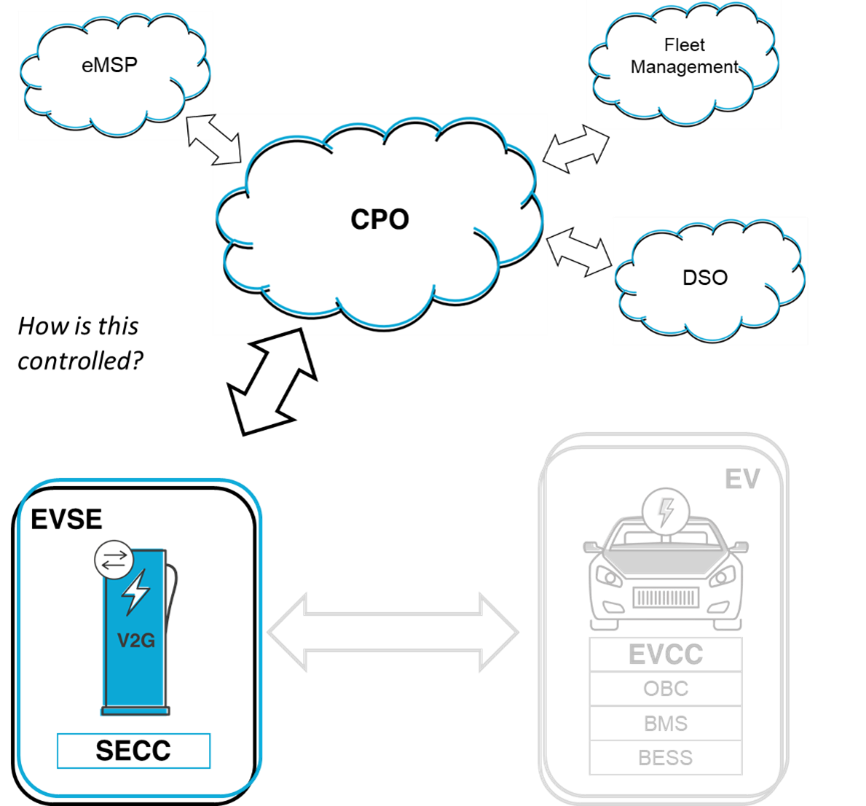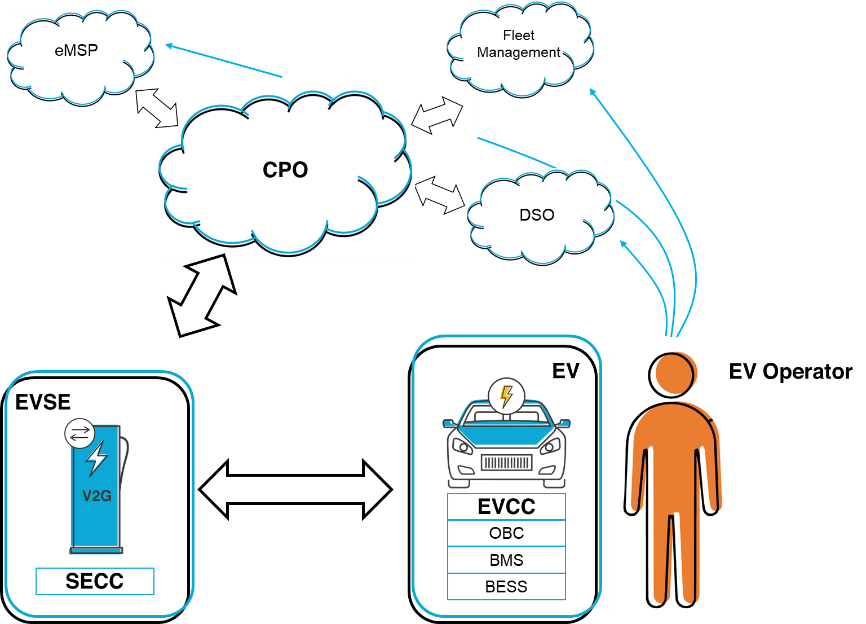V2G Control – EVSE to Chargepoint Operator

Share this step
We have looked at the EV to EVSE interface and learnt a little about how bidirectional charging is controlled locally. However, for many of the use cases for V2G – which we will discuss later on in the course – the local part of the eco-system responds to remote instructions from the Chargepoint Operator (CPO) to charge or discharge. In this step we will take a look at the communications standards and protocols, again at a high level, involved in this control.
 V2G Eco-system – EVSE to CPO
V2G Eco-system – EVSE to CPO
Conventional Charging and OCPP
The key standard for communications between the EVSE and the CPO in conventional EV charging is the Open Chargepoint Protocol (OCPP). This open standard defines the messaging structure to be exchanged between the EVSE and the CPO’s software system – referred to as the Chargepoint Management System (CPMS).
This architecture makes the EVSE the central point of the system, with the instructions from the CPO being sent to the EVSE to then be used locally in the EV to EVSE control system described in the previous step.
In its latest version, 2.0.1, OCPP is implemented in JavaScript Object Notation (JSON) which is an open standard, human-readable, file and data-interchange format. The information sent and received for control of charging transactions include messages for reservation, diagnostics, tariff and cost and authorization. The key set of messages that drives the charging and discharging in V2G is the charging profile which defines the time and power for the power transfer.
Responding to control signals from the CPO is actually only one of four ways in which the EVSE may respond to an external actor. The others are:
- Responding to limits from the EV.
- Responding to local input, such as from a home energy management system.
- Responding to limits imposed by a local chargepoint load management system, designed to control the total load of multiple chargepoints on a single site.
OCPP defines the rules that the chargepoint is to follow when it is asked to respond to signals from multiple actors. One of the key rules is that the charging power shall always be the lowest of any of the schedules for safety purposes.
OCPP and V2G
Version 2.0.1 implemented a number of added and improved functionalities compared to the previous major version, OCCP 1.6. One of these, is support for the ISO 15118 standard. You may remember that this is the standard (ISO 15118-20) that will define how V2G control is done locally between the EVSE and the EV. As ISO 15118-20 is not yet released, OCPP 2.0.1 does not yet include standard functionality to communicate messages relating to bidirectional charging for V2G.
Therefore, for current manufacturers of V2G equipment and the CPO developers of the CPMS, whilst OCPP is often used as the framework for standard EV charging control, additional bespoke work is required to integrate control of a V2G chargepoint. OCPP does allow for custom fields which will often be used by CPOs and V2G EVSE manufacturers to implement this control. Other V2G EVSE manufacturers may choose to also act as the CPO and use their own proprietary CPMS that is not grounded in OCPP.
It is anticipated that when ISO 15118-20 is released and if and when the industry begins to adopt the standard into vehicles and the EVSE, OCPP will catch up to define the CPO to EVSE V2G control functionality.
Further up the chain of command
You may have spotted that there are other entities interfacing with the CPO in the image above. These are there to show that the communications and control does not necessarily stop with the CPO. Depending on the use case for V2G (again, more on these later in the course), there may be other stakeholders involved with the V2G control eco-system. These include:
- e-Mobility Service Provider (eMSP) – This could be a company that provides a phone application which allows the driver to over-ride the V2G schedule if they need to take an unexpected journey and therefore need their vehicle fully charged. After all, EVs are needed primarily to make journeys, the benefits of V2G are secondary. The eMSP may be the same company as the CPO. eMSPs are often linked to the CPO via the Open Charge Point Interface (OCPI).
- Distribution System Operator (DSO) – DSOs have a huge interest in smart charging and V2G as methods by which to optimise the use of their networks. This could even be the sole reason for employing V2G in some contexts in which case the DSO could even act as the CPO. If not, then the CPO and DSO may interact using the Open Smart Charging Protocol (OSCP) which, like OCPP, is currently not yet set up for bidirectional charging but may be updated to be in the future.
- Fleet Management – As with the eMSP, software for managing fleets of vehicles can integrate with the CPO. This may be necessary to adjust charge/discharge schedules due to a change in the operational use of a vehicle. What this means is that the diagram we’ve been using which showed the EVSE as the centre of the V2G eco-system is actually misleading, as in all V2G use cases there will be operators of the EV who will determine how the vehicle is to be used for driving and therefore when and how it is available for V2G. These constraints will feed into those stakeholders that are instructing the V2G, as shown in the below image. How this interface with the EV operators is implemented in a future scenario where V2G is widespread remains to be seen and will depend on the use case for doing V2G in the first place.
 The V2G Control Eco-system Including the EV Operator
The V2G Control Eco-system Including the EV Operator
This is at least the case in current V2G demonstrators; in future V2G systems it could even be that the vehicle knows and communicates its own constraints, removing the need for human interaction with the V2G eco-system.
Key Takeaways
In summary, irrespective of its purpose, there is a lot happening behind the scenes to control a V2G system. If you are to remember four things about V2G control architecture then let it be these:
- There are two key control interfaces in a V2G control system; the CPO to EVSE interface and the EVSE to EV interface.
- The CPO to EVSE interface remotely controls what charging and discharging is to take place. OCPP is the key standard although this does not yet standardise V2G bidirectional charging control.
- The EVSE to EV interface locally controls the power transfer to and from the vehicle battery.
- The primary purpose of EVs is for driving and therefore the V2G control system must adhere to the constraints set by the EV operator.
Share this
Vehicle-to-Grid Charging for Electric Cars


Reach your personal and professional goals
Unlock access to hundreds of expert online courses and degrees from top universities and educators to gain accredited qualifications and professional CV-building certificates.
Join over 18 million learners to launch, switch or build upon your career, all at your own pace, across a wide range of topic areas.
Register to receive updates
-
Create an account to receive our newsletter, course recommendations and promotions.
Register for free







